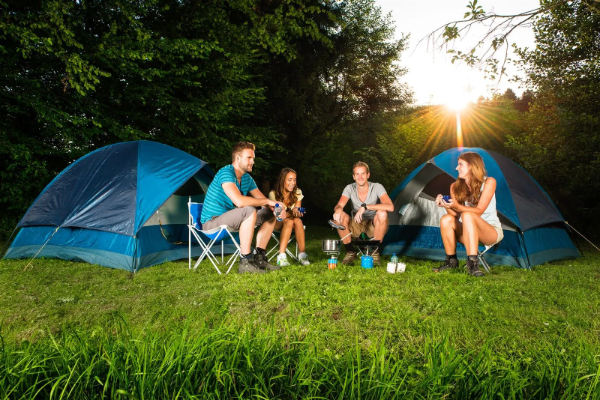When preparing for a camping trip, choosing the right clothing is crucial. Your attire can significantly impact your comfort and safety. Here’s a comprehensive guide to help you decide what to wear camping.
Understand the Climate and Weather
Before packing, research the climate and weather forecast for your camping destination. This information will help you select appropriate clothing.
See Also: What to Bring on a Backpacking Trip
Warm Weather Camping
In warm weather, prioritize lightweight and breathable fabrics. Moisture-wicking materials like polyester or merino wool are ideal. They help keep you dry by drawing sweat away from your skin.
Shirts: Opt for short-sleeve or long-sleeve shirts with UPF protection. This shields your skin from harmful UV rays.
Pants: Lightweight pants that convert to shorts can be versatile. They offer protection from the sun and insects while providing ventilation.
Hats: A wide-brimmed hat can protect your face and neck from the sun. Look for hats with ventilation to keep your head cool.
Footwear: Breathable hiking shoes or sandals are suitable for warm weather. Ensure they have good traction and support.
Cold Weather Camping
In cold weather, layering is key. It helps regulate your body temperature by adding or removing layers as needed.
Base Layer: Start with a moisture-wicking base layer to keep sweat away from your skin. Choose thermal tops and bottoms made of merino wool or synthetic materials.
Middle Layer: The middle layer should provide insulation. Fleece or down jackets are excellent choices. They trap heat and keep you warm.
Outer Layer: The outer layer should protect you from wind and rain. A waterproof and windproof jacket is essential. Look for one with ventilation zippers to release excess heat.
Pants: Insulated pants or thermal leggings can keep your legs warm. Waterproof pants are necessary if you expect rain or snow.
Hats and Gloves: A warm hat and gloves are crucial to prevent heat loss from your head and hands.
Footwear: Insulated and waterproof boots are ideal for cold weather. Wool socks provide additional warmth and moisture management.
Layering for Versatility
Layering allows you to adjust your clothing based on activity level and weather conditions. The three main layers are:
Base Layer: Worn next to your skin, it should wick moisture away.
Middle Layer: Provides insulation and retains body heat.
Outer Layer: Protects against wind, rain, and snow.
By layering, you can easily add or remove clothing to stay comfortable.
Clothing for Different Activities
Your choice of clothing also depends on the activities you plan to do while camping.
Hiking
Shirts: Wear moisture-wicking and breathable shirts.
Pants: Choose durable and flexible pants. Convertible pants are a good option.
Footwear: Sturdy hiking boots with good ankle support are essential. Break them in before your trip.
Socks: Wear moisture-wicking and cushioned socks to prevent blisters.
Swimming
Swimwear: Pack a swimsuit if you plan to swim. Quick-drying fabrics are preferable.
Cover-Up: A lightweight cover-up or rash guard can protect you from the sun when not in the water.
Footwear: Water shoes provide traction and protect your feet from sharp objects.
Fishing
Shirts: Long-sleeve shirts with UV protection are ideal.
Pants: Wear quick-drying pants. Consider pants with zip-off legs for versatility.
Footwear: Waterproof boots or sandals with good grip are suitable.
Sleeping
Sleepwear: Choose comfortable and warm sleepwear. In cold weather, thermal pajamas are a good option.
Layers: Add or remove layers based on the temperature inside your tent.
Fabrics to Consider
Different fabrics offer various benefits. Here are some common options:
Cotton: Comfortable and breathable, but not ideal for wet conditions. It retains moisture and can make you cold.
Merino Wool: Excellent for moisture-wicking and temperature regulation. It’s also odor-resistant.
Synthetic Materials: Polyester and nylon are great for moisture-wicking and quick-drying. They are durable and lightweight.
Fleece: Provides warmth and insulation. It’s breathable and dries quickly.
Additional Gear
In addition to clothing, consider these accessories:
Sunglasses: Protect your eyes from UV rays.
Bandana or Buff: Versatile for sun protection, sweat management, and warmth.
Gaiters: Useful in muddy or snowy conditions to keep debris out of your boots.
Insect Repellent: Wearable repellent like wristbands can help keep bugs away.
Rain Gear: A lightweight poncho or rain jacket is essential in case of rain.
Packing Tips
Plan Ahead: Make a checklist based on the weather forecast and activities.
Pack Light: Choose versatile clothing items that can be layered.
Stay Organized: Use packing cubes to keep your gear organized.
Check the Forecast: Be prepared for sudden changes in weather.
Conclusion
In conclusion, choosing the right clothing and gear for camping is crucial to ensure a comfortable and safe outdoor experience. By following these tips on what to wear for camping, you can enjoy the beauty of nature while staying protected from the elements. Remember to dress in layers, choose breathable fabrics, invest in quality footwear, and pack appropriate headgear, gloves, socks, rain gear, and sleepwear. With the right preparation, your camping trip will be an unforgettable adventure in the great outdoors.

